Fig. 24.1
Map of Argentina
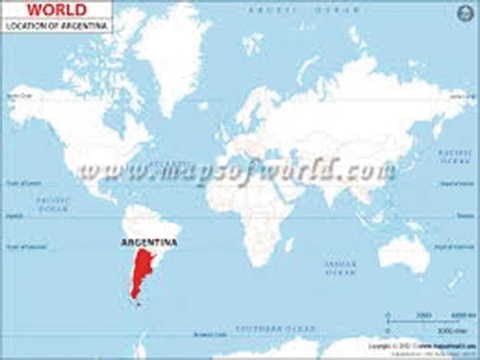
Fig. 24.2
Argentina in the world map
The total population (2013) is 41,446,000 inhabitants, with a life expectancy at birth m/f (years, 2012) of 73/79 years (2012). The probability of dying between 15 and 60 years m/f (per 1000 population, 2012) is of 152/84. The total expenditure on health per capita is US$1551 (2012) and the total expenditure on health as % of GDP (2012) is 8.5 % [5].
Cancer in Argentina
Magnitude of the Problem
Cancer is the main cause of mortality between 45 and 64 years in the country and comprises more than 100,000 new cases and close to 60,000 deaths per year; equivalent to 145 per 100,000 individuals per year. Poverty and educational level strongly influence mortality rates [6].
Cancer Incidence
The International Agency for Research on Cancer (IARC) has estimated that in 2008 Argentina have had 104,859 new cases of malignant tumors (excluding those located in skin histology other than melanoma). This estimate is for both genders to an incidence of 206 new cases per year per 100,000 population. These estimates determine that, in relation to the rest of the world, Argentina has a medium–high cancer incidence. In magnitude, the larger volume of cases corresponds to breast cancer with more than 18,000 new cases per year (18 % of total), followed by prostate cancer (13,000 cases, 13 %). The incidence of cancer, considering all sites except skin non-melanoma is higher in men. However, the incidence of breast cancer in women is higher than that of prostate cancer in men [7] and Fig. 24.3.
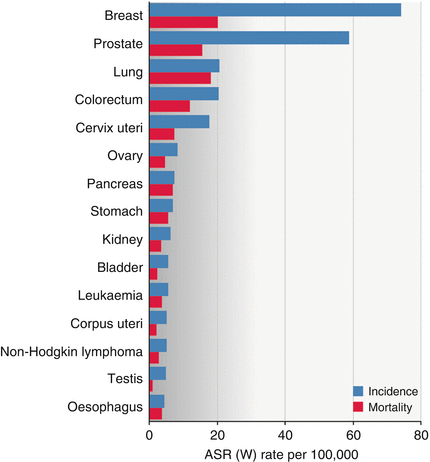

Fig. 24.3
Argentina: estimated age-standardized incidence and mortality rates: both sexes (Globocan 2008-IARC-)
Cancer Mortality
The number of deaths from cancer has increased approximately 9 % in the last decade due to population growth and aging. However, the behavior of mortality was exactly the opposite; Standardized Mortality Rate (SMR) for cancer has decreased 10 %; from 118.82 cases per 100,000 inhabitants in 2001 to 107.49 cases per 100,000 inhabitants in 2011 (Fig. 24.4).
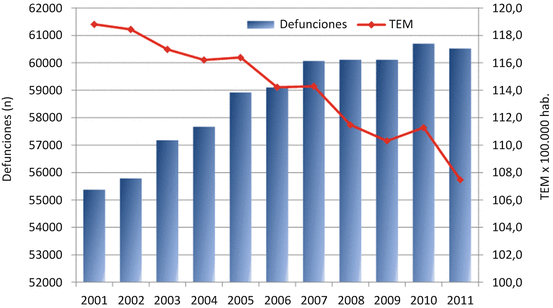

Fig. 24.4
Evolution of cancer mortality—number of deaths and SMR according to world population per 100,000 inhabitants, 2001–2011. Source: SIVER/INC according to DEIS database. Argentina, 2013
In 2011, cancer killed almost 58,000 men and women in Argentina. The Central region of the country, being the most populated, reported more than 70 % of these deaths. Lung cancer is observed in the first place of importance in all regions. Next, in order of frequency are colorectal cancer and breast cancer, except in South and North-West, where third and fourth are prostate cancer and stomach, respectively. Cervical cancer is registered in tenth place in the country and is among the five leading causes of cancer death in the North-East region [8].
Mortality from Lung Cancer: Decreased in Men and Increased in Women
In Argentina, lung cancer mortality in men has declined since 1980 at a sustained rate of 1.3 % annually. However, it increased in women—even at a steady pace—of nearly 2 % (Fig. 24.5). In this way, while in 1980 the gap between the genders was 37.7, in 2010 decreased to 19.7 deaths per 100,000 population.
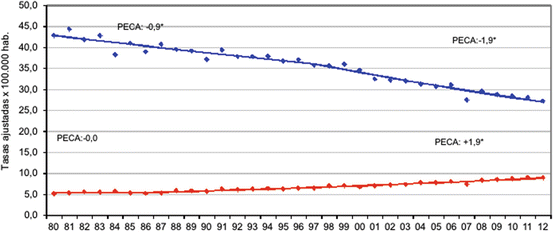

Fig. 24.5
Specific mortality by lung cancer in man (blue line) and women (red line) standardized rates by age according to the world population per 100,000 inhabitants. Argentina, 1980–2012. Source: SIVER/INC–Ministry of Health, based in mortality registries from DEIS-Argentina, 2014
Mortality from Colorectal Cancer: Decreased in Women and Increased in Men
Colorectal cancer mortality decreased in women since 1980 at a sustained rate of 0.8 % annually. However, in men this cancer mortality increased in the period 2002–2010 with an estimated annual change of 1 % (Fig. 24.6).
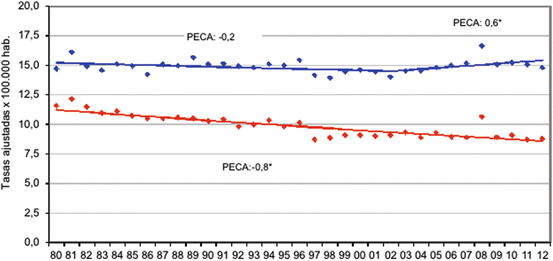

Fig. 24.6
Specific mortality by colorectal cancer in man (blue line) and women (red line) Standardized rates by age according to the world population per 100,000 inhabitants. Argentina, 1980–2012. Source: SIVER/INC–Ministry of Health, based in mortality registries from DEIS-Argentina, 2014
National Cancer Institute of Argentina
The National Cancer Institute of Argentina (INC)) is a body dependent on the Ministry of Health. Created on September 9, 2010 by Presidential Decree 1286, is responsible for the development and implementation of health policies and the coordination of integrated prevention and cancer control actions. Its main objective is to reduce cancer incidence and mortality in Argentina, as well as improve the quality of life of those affected by the disease.
Among its functions, the INC is responsible for coordinating promotion and prevention of cancer, early detection, treatment, and rehabilitation, as well as cancer research and human resources training in the country. The scope of activities include the development of standards for the comprehensive care of patients with cancer, promoting health and reducing risk factors, defining strategies for prevention and early detection, training of professionals, and the establishment of surveillance systems and epidemiological analysis.
The creation of the INC in Argentina was a decision of great significance in the health agenda of the government, and the main reason was to promote cancer control at the policy level, with the coordination of all actions nationwide, according to the available resources, culturally adapted and taking advantage of the existing resources of the Health System of the country.
Main programs of INC are: National Program for Cervical, Colon, and Breast cancers, together with a National Plan for Familiar and Hereditary Tumors, whose primary mission is “to improve the detection, management and prevention of high-risk groups in the Argentinean population,” contributing to the development of a hereditary tumor registry and the national development of a comprehensive network of care. The pediatric area aims to improve the morbidity and mortality of children and adolescents with childhood cancer and their social rehabilitation after specific treatment, through equitable access to quality health care. The Palliative Care program promotes continuous and integrated care for all cancer patients throughout their . disease, with particular emphasis on reducing their suffering and improving their quality of life for patients and families. Getting pain relief and access to opioid medication is an effective reality for all patients in the country, removing barriers to drugs access. The Tobacco Control Program general objective is to promote the production of scientific knowledge for the formulation of public policies planned to protect people from the effects of tobacco and the exposure to smoke snuff.
Fellowships and Educational Workshops . are also part of the activities, together with the Departments of Cancer Research, Epidemiological surveillance, Evaluation of Health Technologies, and Communication and Cancer Registries.
INC maintains continuous . collaboration with national, regional, and international organizations such as the Pan American Health Organization (PAHO) , National Cancer Institute-US (NCI-US) , IARC, International Atomic Energy Agency (IAEA) through the Program for Action for Cancer Therapy (PACT) , the Network of Latin-American Cancer Institutes (RINC) , and others [9].
Breast Cancer
National Breast Cancer Program
Breast cancer is a major health problem of Argentine women, since it is the leading cause of cancer deaths in women. Annually, 5400 deaths from this disease and it is estimated that 18,000 new cases occur each year, representing 17.8 % of total cancer incidence in Argentina (Fig. 24.7).
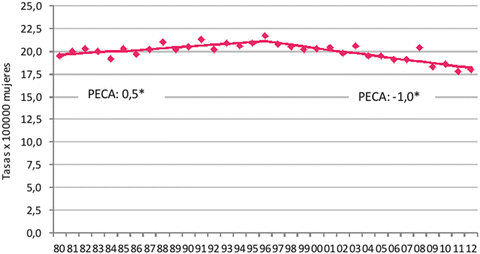

Fig. 24.7
Specific mortality by breast cancer in women (red line) standardized rates by age according to the world population per 100,000 inhabitants. Argentina, 1980–2012. Source: SIVER/INC–Ministry of Health, based in mortality registries from DEIS-Argentina, 2014
The overall objective of the National Breast Cancer Program is to reduce morbidity and mortality associated with the disease. This program is based on the findings of a Situational Diagnosis of the National and Provincial Programs, conducted between 2009 and 2010 in the area of the Secretary for Community Health of the Ministry of Health, with technical and financial support from the PAHO.
Current Actions
The three axes of the National Breast Cancer Program are quality control, coverage, and monitoring.
Quality control procedures imply that the detection, diagnosis, and treatment of women at risk, or with suspected or confirmed cancer, have the required quality services to ensure the best results.
Coverage is the ability of a program to reach people in need. Most of the population knows he has to stay healthy, but not everyone has the same opportunities to do so. In this sense, the program must work towards removing barriers that prevent access to coverage as lack of information, lack of time, overcharging for work, children, dependents, lack of money to get to hospital, and various complications to access the benefits of the health service. During 2012, the program generated social research inputs in order to build an appropriate strategy.
The third axis of the program is the implementation of a monitoring system to provide data on program performance as well as how many mammograms were performed, number of women screened, age of presentation, and how many cancers were diagnosed. This information is essential to achieve quality in mammography studies. Thus, the program has implemented a breast cancer computerized system (SITAM) for data collection and follow-up of the screened population.
The program has also developed manuals, guidelines, educational material for general population, patients, and health care providers as well as a newsletter.
Cervical Cancer
Cervical cancer is an indicator of health inequity. In Argentina , approximately 4000 new cases are diagnosed each year and 1800 women die from the disease. The mortality rate adjusted for age is 7/100,000 women (Fig. 24.8). The burden of disease and mortality varies by province, being higher in populations with lower socioeconomic development. Argentina defined as a priority a comprehensive approach to prevent cervical cancer, with the aim of reducing mortality from the disease, which includes incorporating HPV vaccine for girls 11 years and the strengthening of the prevention strategy through secondary screening based on cytology, and the introduction of the HPV test as a primary screening.
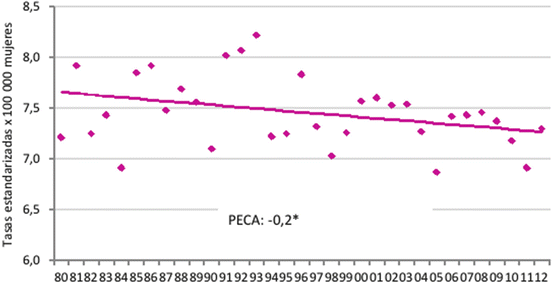

Fig. 24.8
Specific mortality by cervical-uterine cancer in women. Standardized rates by age according to the world population per 100,000 inhabitants. Argentina, 1980–2012. Source: SIVER/INC–Ministry of Health, based in mortality registries from DEIS-Argentina, 2014
The implementation of actions to control the disease is part of the National Cancer Institute strategy, through the National Program for Cervical Cancer Prevention (PNPCC). Current programs ongoing include:
(a)
Implementation of the project to incorporate the HPV test as a primary screening in the province of Jujuy, in conjunction with the PNPCC and the Ministry of Health of the province of Jujuy.
Main activities: workshops in counseling and communication strategy for health teams; refresher training in colposcopy for cervical pathology ). specialists; establishing circuits for finding women with positive HPV results and abnormal PAP; development of communication materials for the introduction of the HPV Test.
(b)
Development of scientific evidence and technical assistance for incorporating HPV test as primary screening.
Main activities: development of a Manual for the inclusion of the HPV Test; development of a communication strategy based on HPV Test; ). activities to support the PNPCC; research development “Welcome, circulation, and assessment of media communications: the HPV test campaign.”
(c)
EMA Implementation Project (evaluation of self-sampling test mode HPV), in conjunction with the PNPCC, Ministry of Health of the province of Jujuy, and IARC-WHO, in order to assess the performance test by self-sampling method and its effectiveness to increase coverage of screening programs.
Main activities: development of the protocol; ). development of communication materials; ongoing training workshops with health workers and primary health care teams involved in the project; monitoring of project development.
(d)
Establishing quality criteria for the operation of cytology laboratories.
Main activities: development of quality control for ). cytology laboratories; study about the correlation of cytology and histology.
HPV Vaccination
In Argentina , human papillomavirus (HPV) vaccination was approved in 2006, but not included in the National Immunization Program (NIP). In 2008, a mass media campaign was carried out by a cancer Non-Governmental Organization (NGO), but it was stopped due to criticisms about the publicity. In October 2011, the Ministry of Health (MoH) has introduced HPV vaccination in the NIP. It is mandatory and free to all girls, 11 years old and according to data from the NIP the compliance to the vaccine is currently over 90 % [10].
Pediatric Cancer
In the population under 15 years, according to information provided by the Argentine Oncology Pediatric Registry (ROHA) , the annual incidence rate in Argentina is about 124 cases per million in children of this age. The cancers most frequently observed in the period 2000–2007 were: leukemia (30–40 %, about 470 cases annually), brain tumors (20 %, about 240 cases annually), and lymphomas (13 %). The chance of survival of these children in developed countries has been increasing to rates of 70 and 80 % due to early diagnosis, proper treatment, and comprehensive care. However, in Argentina the survival of children with cancer is around 65 % due to various conditions, including loss of opportunity for proper diagnosis, lack of timely referral, treatment complications, and in some cases, lack of comprehensive patient care [11].
It is important to underline that all new cases of pediatric cancer are registered at the country level by ROHA. With respect of access to treatment, the best care is available in big cities (Buenos Aires, Cordoba, Santa Fe, and Mendoza). In several provinces or cities that lack of pediatric oncology care, the patients must be transferred to specialized centers in the main cities.
Stay updated, free articles. Join our Telegram channel

Full access? Get Clinical Tree





